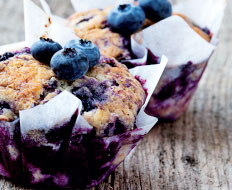When you consider that one of the world’s most perfect comfort foods—the basic French baguette—is made of nothing more than flour, yeast, salt, and water, it’s a wonder we, as human beings, ever decided to expand on this basic formula.
But expand we have, creatively, conceptually, and calorically. Working with basic bread as our framework and inspiration, we’ve managed to devise not just endless variations on the stuff some call the “staff of life,” but also the dizzying array of delectables on display at any decent bakery, pastry shop, or café today: bagels, buns, brioche, cookies, cakes, croissants, doughnuts, danishes, muffins, turnovers, streudel, scones … you get the idea.
Indeed, so amply stocked are our bakery shelves nowadays that it’s easy to forget how much further we can ride this train. Sure, it may seem as though there’s already a bread or pastry suitable for just about every imaginable culinary function. But the truth is, there’s still room for reinvention and rediscovery. A few suggestions:
1. Keep the better-tasting gluten-free variations coming. It’s hard to imagine that the gluten-free category hasn’t already been thoroughly exploited. And yet, in March, The NPD Group reported that one-third of all U.S. adults had stated an intent to reduce or remove gluten from their diets—a far higher percentage than might be expected, given that the National Institutes of Health has pegged the incidence of celiac disease in the population at around 1 percent. Still, if consumers are true to their word, the need for additional—and, more importantly, better-tasting—gluten-free options is going to become even more acute.
The first generation of gluten-free baked goods was, somewhat predictably, pretty awful: bland, dull, and flavorless. Now, though, as restaurants and packaged-goods firms continue experimenting with different ingredients and preparations, we’re seeing more gluten-free offerings that do a pretty good job of mimicking their gluten-rich counterparts. Chefs and product-development experts have been exceptionally creative at identifying alternative flours made from sources ranging from rice to cassava to chestnuts, almonds, and ground grape seeds and skins. And their ingenuity is leading to some impressive results: From Dunkin’ Donuts’ gluten-free muffins and doughnuts to entire gluten-free menus at the likes of P.F. Chang’s and Chevy’s, chains are finding that it’s not just possible, but also profitable, to sidestep wheat flour and still devise menu items that satisfy.
2. Keep looking back with longing. In our nostalgic American cast of mind, everything old is new. But when it comes to baked goods, some old things are newer than others. In the case of bagels, which need no introduction to U.S. consumers but whose popularity ebbed somewhat during the low-carb craze of the late ’90s and early 2000s, the old rolls with holes are back with a vengeance. A number of outlets are now offering artisanal bagels—those that have been hand-rolled and wood-fired for a taste and texture that represents an appealing upgrade from the norm. What you won’t find at many of these establishments are deviations from standard or traditional bagel operating procedure. Onion, poppy seed, garlic, and salt varieties make the cut, but anything with sun-dried tomato, cinnamon and raisin, or Cheddar cheese is strictly verboten. “Even an ‘everything’ bagel pushes the limits of authenticity,” trumpets the website of Schmendricks, a San Francisco establishment with a serious purist’s streak and a bias for Brooklyn bagels. At Beauty’s Bagel Shop in Oakland, California, the Montreal-style variations also tend toward the traditional.
In a similar vein, the humble pretzel continues to be twisted and turned for all it’s worth. Bill Corbett, executive pastry chef of San Francisco’s Absinthe Group and a member of CCD Innovation’s Chefs’ Council, makes pretzel croissants that are simply out of this world. And on a national level, Wendy’s has engineered a pretzel bun burger that has no doubt inspired competing menu developers to give the tried-and-true pretzel a fresh look.
Finally, there’s toast. It might not seem ripe for a major revival, but I suspect that once you’ve dug into the cinnamon toast with vanilla-scented Vermont butter and maple syrup at Miami’s Acme Bakery—or the toasted chocolate bread with vanilla Ricotta, honey, almonds, preserves, and butter at Craftsman and Wolves in San Francisco’s Mission District—you may change your mind.
3. Keep scanning the map for regional and ethnic options and updates. Whether you choose to home in on U.S. regional variations—Southern biscuits and pies or Northeastern maple scones, for example—or whether you focus your attentions on sticky toffee puddings from Britain, Belgian speculoos cookies, or the entire universe of French pastries, keeping an open mind and wide-open eyes can generate plenty of novel product ideas.
The beauty of baked goods is that they’re nearly universal; very few Americans who’ve ever tasted a danish or coffee cake would likely be dumbfounded or confused by encountering a brioche or slice of streudel. That high level of consumer comfort with foods powered by flour gives you liberal license to explore and experiment. I look forward to hearing your success stories in months and years to come.









